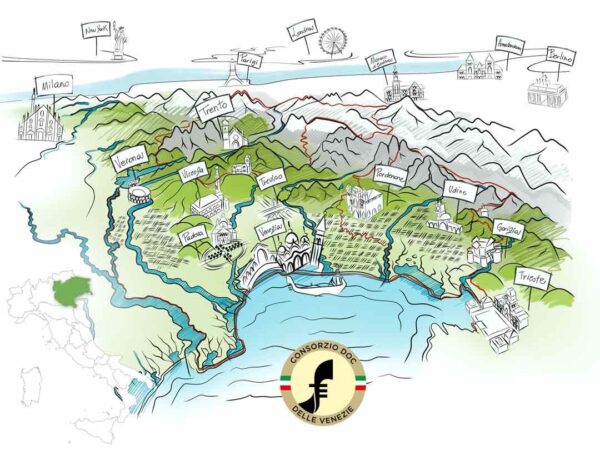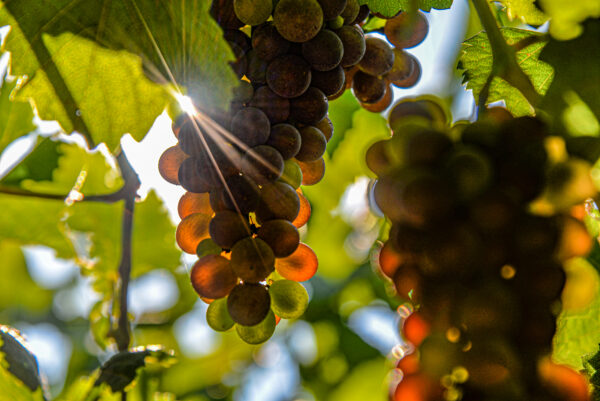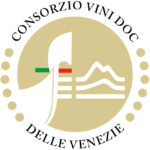There’s liquid gold found amid the undulating hills and jutting mountains of northeastern Italy. It’s Pinot Grigio. Italy leads the world in production and sales of this versatile white varietal, and the finest examples are from the Pinot Grigio delle Venezie production zones, also known as Triveneto.
The Triveneto area encompasses the regions of Veneto and Friuli-Venezia-Giulia and the province of Trento (Trentino). That’s around 27,000 hectares (67,000 acres) stretching from the eastern shore of Lake Garda to the Adriatic Sea, north to the Dolomites and south to Padova. These Delle Venezie appellations produce 82% of Italy’s Pinot Grigio. That’s approximately 233 million bottles. The U.S.A. is the largest export market, buying 37% of Pinot Grigio delle Venezie.

Map courtesy of Consorzio DOC Delle Venezie
A grape rooted in Europe that became an Italian star
Viticultural historians place the origins of this variety in Burgundy France where Pinot Gris evolved as a mutation of Pinot Noir centuries ago. Gris or Grigio refers to the dusky grayish-pink hue of the grape skins. This variety is now found in many parts of the world and often under different names such as Rülander and Grauburgunder in Germany and Szürkebarát in Hungary.
Pinot Grigio was introduced into Italy in 1800 where it has flourished most notably in the cooler and temperate climates to the north in Delle Venezie. Cool climate, higher altitude Pinot Grigio tends to have increased acid levels and lighter crispness. On the palate, one can find notes of green apple, pear, citrus, tropical fruit, and even almond, peach and honeysuckle, depending on where it is produced.

Pinot Grigio grapes on vine. (Consorzio delle Venezie). Photo credot: ©EnricoBrunelli-2519
A Protected Region and Wine in Italy
The Consorzio Vini DOC delle Venezie was established in 2017 to uphold the quality image of Pinot Grigio produced in the three Triveneto production zones and establish rigorous quality control and certification guidelines. These include:
- Four styles of wine may be produced under the DOC: Bianco (still white) Rosato (ramato/rosé) Spumante (sparkling) and Frizzante.
- The wines must contain minimum of 85% Pinot Grigio delle Venezie. Other permitted white grape varieties include (maximum 15%): Chardonnay, Friulano, Garganega, Muller-Thurgau, Pinot Bianco, and/or Verduzzo and other unspecified nonaromatic white grapes (until 2027).
- Minimum alcohol levels are 11%
- Pinot Grigio varietal wines must be labeled as “Pinot Grigio delle Venezie DOC”
These strict guidelines assure both professional wine buyers and wine consumers that they are purchasing authentic, quality European wines made in Italy and produced in Pinot Grigio delle Venezie.

Pinot Grigio delle Venezie is produced in four different styles: Bianco, Rosato, Spumante and Frizzante. It’s a versatile white wine to pair with many types of cuisine.
In our next article, we’ll discuss different styles of Pinot Grigio delle Venezie and how to enjoy them with different food pairings, and we will share a wine cocktail or two. Salute!
 For more information visit Consorzio Delle Venezie
For more information visit Consorzio Delle Venezie

This article has been financed with help from the European Union. This article is original content written by the author and all opinions are those of the author. The European Commission and the European and the European Research Executive Agency (REA) do not accept any responsibility for any use that may be made of the information it contains.
The Consorzio Vini DOC delle Venezie reminds you to drink responsibly.
